Bergamot for anxiety, poor sleep & PTSD; and other Essential Oils for PTSD & even better when used at Acupressure points
3 books about essential oils and health.
“First Aid with Essential Oils is within the Scope of Self-Care.” - Max Stanley Chartrand, Ph.D. CSP (Behavioral Medicine)
“Self-Care: the practice of taking action to preserve or improve one’s own health.” Oxford Dictionary
(page 94, The Incredible Power of Essential Oils, 3rd Ed., M.S. Chartrand, 2023, oillife.com)
Essential Oils and Acupressure
I have also been learning about use of essential oils with acupressure. Oils with similar properties as an acupressure point can increase healing benefits.
Book: ‘Acupressure with Essential Oils - A Self-Care Guide to Enhance Your Health and Lift Your Spirit’, by Merina Ty-Kisera, LAC, 2019. ($17.95) (oillife.com) And a low cost ($5) recording of a class by the author, demonstrating some points and oils to use is available on the site too.
Bergamot essential oil is calming and extra calming when applied at an acupressure point within the earlobes. Add a drop to pinkie fingertips and press on a spot in the upper earlobe, a little more towards the head side of the ear. Hold for 1-3 minutes. Firm but not painful pressure. Muscle pain points can like deeper pressure than other acupressure points. (oillife.com/acupressure-essential-oils-workshop)
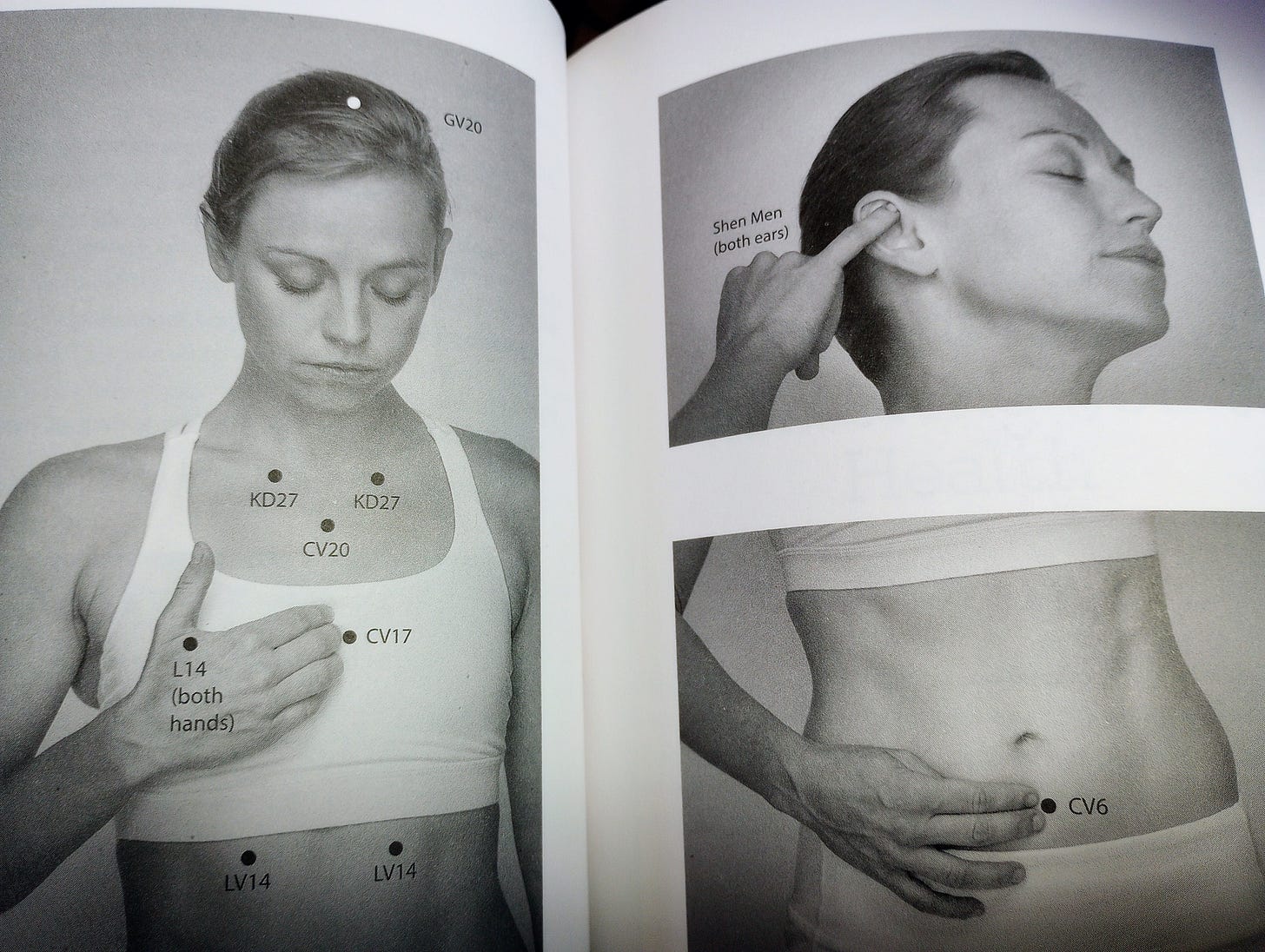
Stimulating our acupressure points is stimulating the stem cell producing nodes within our Primo Vascular System. Homeopathic remedies that are properly made are also likely working by affecting our own stem cell production. They have been found to have nanoparticles of the original herb or chemical used to prepare the homeopathic remedy. Different remedies or different essential oils would likely be promoting different types of stem cells to form for whatever body part is needing the help.
Pretending that health discoveries aren’t true, is really holding back the efficacy and safety of Western Medicine.
Bergamot essential oil is a calming prize winner.
Bergamot for PTSD treatment has been found helpful in a clinical research trial (only two weeks long, n=12 first responder firefighter or military personnel). Participants using bergamot essential oil reported “a calming effect, improved sleep, reduced anxiety, increased positive mood, enhanced concentration and reduced avoidance behavior.” (page 12) From another new book, a doctoral dissertation in book form: Mental Health & Aromatherapy - A Guide to PTSD and Essential Oils, by Dr. Danielle Daniel, 2020, $22.99. (Daniel, 2020, oillife.com) *I am unaffiliated, just sharing the link where I purchased the books.
This is a very good book on PTSD. It is an academic paper in the writing style but very readable with useful reference information and empowering feedback from the 12 participants in Dr. Daniel’s study with Bergamot essential oil for PTSD symptoms. She was focused a bit on reducing avoidance behavior as it is very common for people with PTSD to go to extremes to not be triggered into the trauma memories - which I can attest to. The Bergamot was most effective for the majority of participants for calming their stress or anxiety, improving sleep, and the effects were fairly immediate for the sleep improvement and were most noticeable for calming by day seven of the the 14 day study. Interestingly, the participants noticed that the calming effect increased as the days elapsed - ten minutes of calm after inhalation turned into thirty minutes of calm. One person forgot to use it on day 11 but still felt better than prior to the study onset. That suggests that the body and brain were building more calm pathways without having to do six weeks of practicing meditation or mindfulness to achieve it. Essential oils are acute treatments - very fast, because aroma is entering the brain so quickly and it enters the emotional limbic center and the Reticular Activating System (RAS) where negative or positive associations can form that are so strong they can be lifelong.
Bergamont flower, also called Bee Balm, is an herb used in Earl Grey Tea and it has a nice smell but is not the Bergamot of Bergamot essential oil. Addition - Earl Grey Tea uses the citrus fruit Bergamot (healthline.com/bergamot-tea) not the wildflower Bee Balm. I learned something today. Bee Balm flowers are edible and a Native American tribal group used the leaves in tea. It does have medicinal properties. Bees and hummingbirds love the magenta red variety of Monarda/Bergamont/Bee Balm. (plants.ces.ncsu.edu/monarda-didyma/)
“As a member of the mint family it is very aromatic and the leaves smell of oregano. Native Americans inhaled the steam of the upper parts of Monarda to treat coughs, fevers and lung congestion. Monarda is specific for fever, lung congestion and cool, clammy skin. The leaves are used to make a refreshing tea.” (acornherbschool.com/bee-balm-monarda)

Bergamot essential oil is made from a citrus family plant, Citrus aurantium bergamia. It is also called Sour Orange. The fruit is the size of an orange but looks the color of a lime, either green when less ripe or yellow when more ripe. But I seem to tolerate it okay - no histamine reaction.
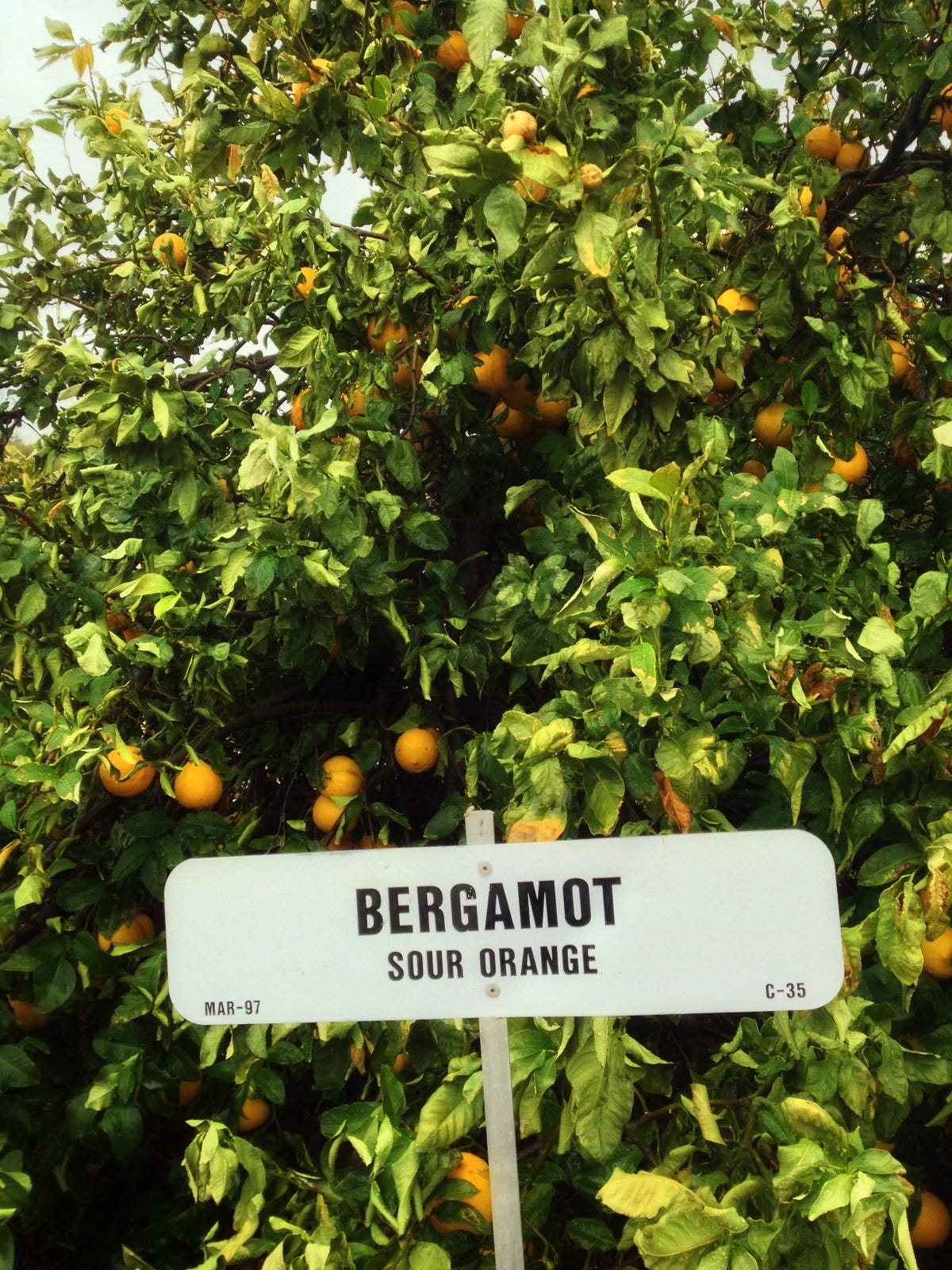
Coincidentally or causally, Bergamot happens to be the essential oil that I have been using daily in my upstairs area. It is slightly flowery smelling but not intensely floral. I use eucalyptus and a homemade blend of other tree essential oils in my sleep area. I love it. Forest bathing all night long.
Other benefits of Bergamot essential oil include:
Lowered blood sugar 25% in patients with Type 2 diabetes.
Significantly reduced LDL cholesterol and triglycerides and raised HDL cholesterol.
Helpful for resolving pancreatitis for which there is minimal effective treatments in standard medicine.
Helps with weight loss if overweight or obese.
Antioxidant benefits in cancer, cardiovascular disease, or other inflammatory conditions.
Helpful for rheumatoid arthritis, urinary tract infection and for lethargy, depression, and anxiety.
Little or no adverse side effects.
(page 24-25, The Incredible Power of Essential Oils, 3rd Ed., M.S. Chartrand, 2023, oillife.com, sale price $15)
*The book by Max Chartrand is a short read and has a couple pages with formatting issues - missing text/duplicated text, but the book is printed on very high quality paper and the font is easy to read. He includes essential oil recommendations and recipes for various health conditions. The book is fascinating in that it gets in detail about our interstitium space under our skin and how it is involved in chronic infection - again tooth or jaw infection is a big risk to the rest of the body as it spreads through the lymphatic system and interstitial spaces. Ear issues are a focus as Dr. Chartrand lost his hearing at a young age. His PhD’s are in Communicative Disorders and Behavioral Medicine. His focus is on preventive health through behavior change and translational medicine - getting the cutting edge research to the patients in need. This was a page turner book - I read it cover to cover, last night and this morning. I don’t agree with it 100% but I learned a lot from it.
Other oils with animal or human research on fear, anxiety or PTSD include:
Cardamom essential oil to improve GABA, believed to be due to the quercetin content. It has phospholipid content which might aid endocannabinoid production.
Aromatic turmerones found in Turmeric essential oil helped reduce neuroinflammation, reverse memory deficits and increase cerebral blood flow to areas of the brain that are affected by PTSD such as the hippocampus, amygdala and areas of the prefrontal cortex.
Agarwood essential oil has a long history of use in Southeast Asia and the Middle East for tranquilizing properties - reducing excitement or fright and improving forgetfulness. Research has shown calming effects are due to modulation of GABA. It also was found to decrease corticotropin releasing hormone (CRH) reducing hyperactivity of the HPA axis. It also reduced concentrations of corticosterone and adrenocorticotropic hormone (ACTH) during stress. An overactive stress response is common in PTSD.
“Corticotropin-releasing factor (CRF) plays a central role in the stress response by regulating the hypothalamic-pituitary-adrenal (HPA) axis. In response to stress, CRF initiates a cascade of events that culminate in the release of glucocorticoids from the adrenal cortex.” (Smith, Vale, 2006)
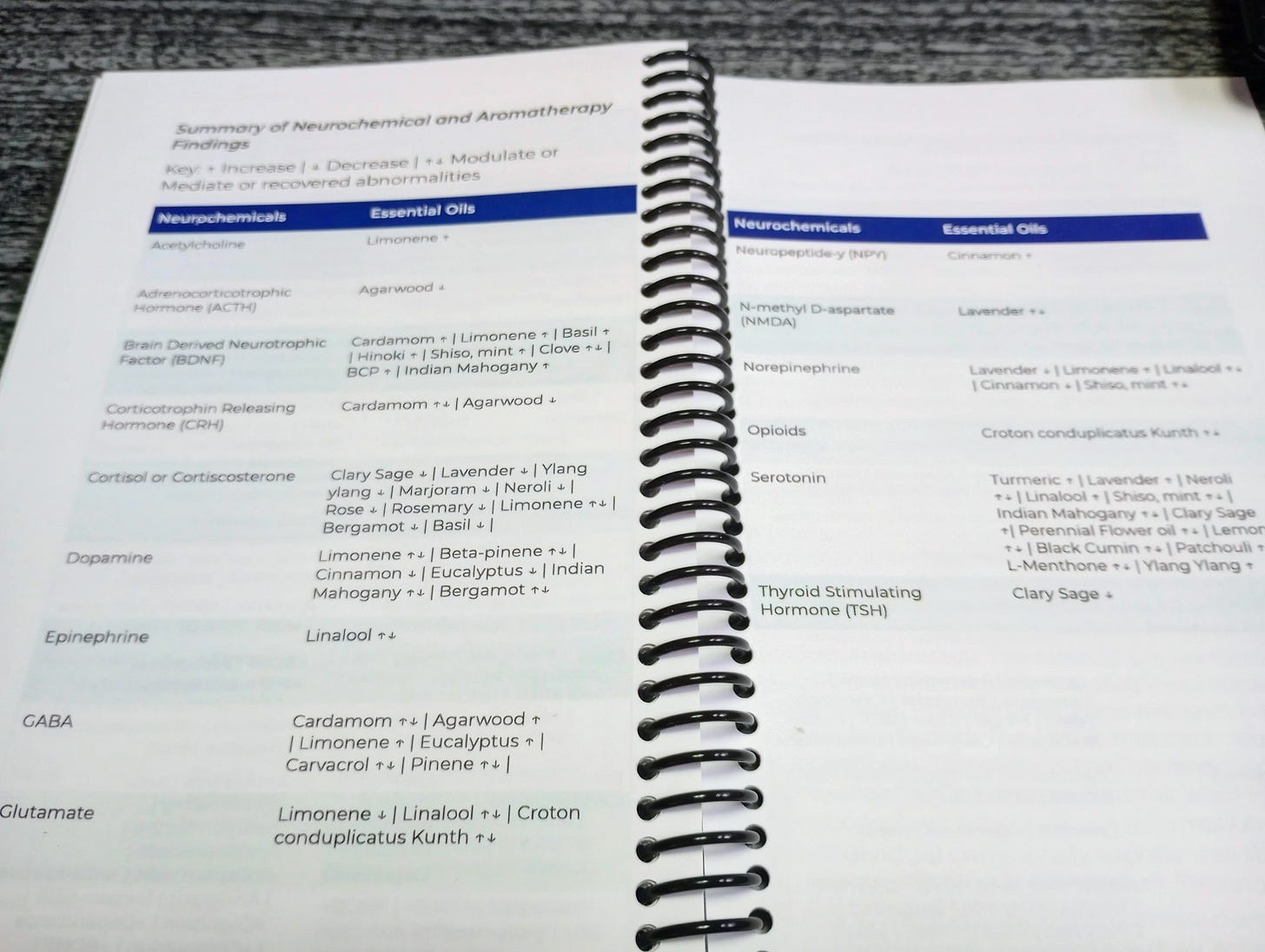
Neroli essential oil reduces anxiety and depression by regulation of 5-HT receptors (serotonin receptors). Neroli is a citrus oil and limonene is the primary aromatic with bioactive properties in it. A human clinical trial found that daily use led to a reduction in systolic and diastolic blood pressure suggesting it is reducing stress by effects on the autonomic nervous system (which is what causes the fright/flight/freeze fear response). Other human trials found it helpful to reduce anxiety during labor, and in hospitalized heart patients, and for preoperative anxiety. This oil has had quite a bit of research showing benefits as a motor relaxant, and promotes calming, uplifting or soothing feelings and has sedative properties. Limonene gets its own section in the book.
Cinnamon essential oil may promote neuropeptide-y (NPY) which tends to be low in PTSD.
Basil essential oil helped reduce depression and negative effects from stress by increasing the protein BDNF which is protective within the brain and hippocampal nerve cell atrophy was reduced and new growth, neurogenesis increased.
Hinoki essential oil also has been studied for stress, anxiety and increased expression of BDNF protein. Hinoki oil is from a cypress tree species in Japan. Action on the autonomic nervous system has been shown with reductions in heart rate and blood pressure leading to relaxation and improved mood. It also seems to have CNS effects but a mechanism of action is not known.
Shiso, mint - L. Britton essential oil known as Shiso, also has BDNF benefits and improved hippocampal 5-HT (5-HT = serotonin). Primary phytonutrients are L-perillaldehyde, limonene, and beta-caryophyllene which is a CB2 endocannabinoid receptor agonist.
Clove essential oil also has DNF benefits, protecting the hippocampus and reducing Alzheimer’s dementia risk. Primary phytonutrients - eugenol (71%) and beta-caryophyllene (10%).
and Lavender Essential Oil
Lavender essential oil helps reduce our anxiety response due to effects on the serotonin system. It has sedative effects and can reduce the fear response (“via the c-Fos expression related to aversive memory in the limbic structure”, (page 64, Daniel, 2020, oillife.com) and agitated behavior. It calms the autonomic nervous system with a decrease in heart rate and blood pressure and also calms the central nervous system. Increases in theta and alpha brain waves are seen after inhalation of lavender. Lavender oil can bind with NMDA receptors and reduce anxiety, depression and modulates neurochemicals in a protective way. (Overactivity of NMDA receptors is part of the cause of hippocampal damage in Alzheimer’s dementia, a condition which is more common among PTSD patients than average populations.) The active aromatics linalool and linalyl acetate are also found in a number of other essential oils. Linalool inhibits glutamate binding which would protect against hippocampus damage and reduce Alzheimer’s risk.
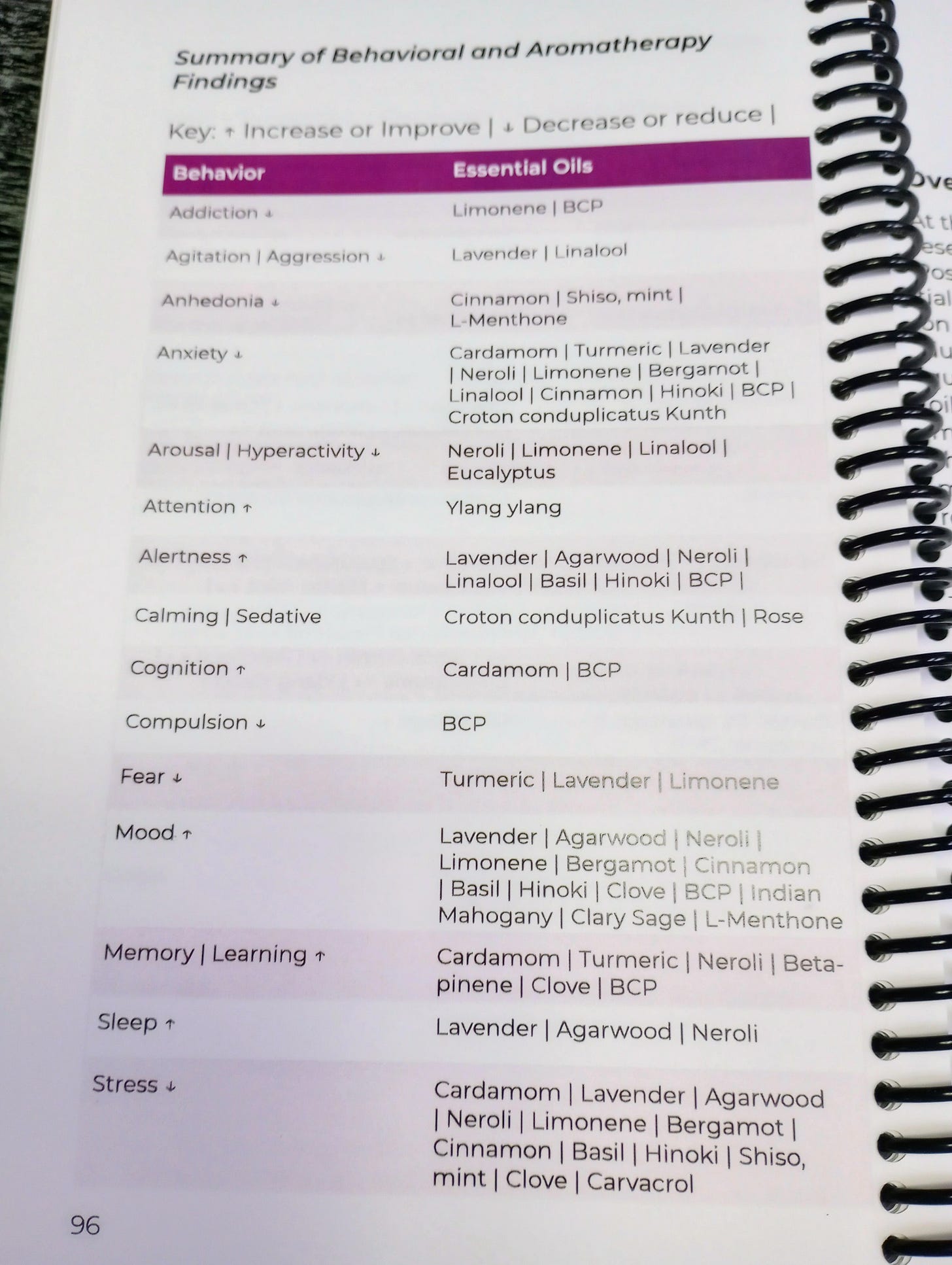
Other oils that may help with serotonin levels include: clary sage, ylang ylang, lemon, shiso mint oil, black cumin oil, Indian mahogany, and perennial flower oil.
Other oils that may help with GABA activity include: thyme oil, and the pinene found in lemon and lavender oils.
Stop to smell the roses because rose phytonutrients are calming for stress by inhibiting the hypothalamic-pituitary-adrenal (HPA) axis.

Oils showing a reduction in cortisol levels in response to stress include: rose, rosemary, lavender, marjoram, and clary sage. Rose oil is known to have calming effects due to inhibition of the HPA axis. Clary sage also reduced TSH levels which can become elevated in PTSD and hyperthyroidism is more common than in average populations.
Bergamot may be so helpful because it contains limonene, linalool, and linalyl acetate and beta-pinene which is also calming.
This section is based on pages 60-83, Daniel, 2020, oillife.com.
Quality is a concern, products may be made with less potent parts of the plant or gathered at the wrong time in the growing season. Cheaper oils might be substituted or thinned with vegetable oils or alcohol or other synthetic or petrochemicals. A blind analysis randomly selecting three products from eleven companies found only three to be truly pure - doTerra, Ameo and Aromatics International. The other brands had some marker of impurity - Young Living is another MLM company; Now and Mountain Rose Herbs are brands I’ve found helpful, and Plant Therapy, Edens Garden, Artisan Aromatics, Aura Cacia, and Rocky Mountain Oils. (consumersadvocate.org cited by Daniel, 2020, oillife.com, page 86.)
My own Forest blend would be providing quite a bit of pinene and it has Bergamot. Lemongrass has l-limonene while citrus oils have d-limonene - chemically they are mirror images of each other.
I filled a 15 ml bottle with a variety of tree oils plus a few others and I use about 6 drops of the mix with six of eucalyptus in my humidifying diffuser. It is so nice to sleep within a forest facsimile.
Cypress, Douglas Fir, Black Spruce, Birch, Tea Tree oil, Rosemary, Bergamot, Lemongrass, ~ 30 drops of each
Frankincense ~ 20 drops
Myrrh ~ a few drops
I use a mix of brands. The doTerra oils may have some nice aspects but NOW brand Clove oil stops a toothache too. Eucalyptus oil from NOW or Rose Mountain Herbs helps clear my nose well. I like the Breathe blend by doTerra too, but daily use in a diffuser does use quite a bit of oil over time.
Ideally, idealism is great,
but realistically, realism is better. - Me
The Myrrh is kind of expensive and is an edible oil with cognitive health benefits potentially against Alzheimer’s risks. Its aroma is good in a hot beverage and i have been adding it or Roman Chamomile essential oil to my hot structured water beverage. I add about a teaspoon of MCT oil to 3 cups of boiling water with about a half teaspoon of vanilla and I add some CBD and THC drops and the essential oil drop or drops. One drop leaves the Myrrh bottle usually but a couple usually fall out of the Roman Chamomile bottle and the flavor isn’t too intense. Blend at high speed for about 30-40 seconds to make the frothy structured water. I also use hot tea or coffee occasionally as the liquid base.
Disclaimer: This information is being provided for educational purposes within the guidelines of Fair Use. It is not intended to provide individual health care guidance.
Reference List
Chartrand, M.S., The Incredible Power of Essential Oils, 3rd Ed., 2023, Digicare Research Foundation. oillife.com
Daniel, Danielle, Mental Health & Aromatherapy - A Guide to PTSD and Essential Oils, 2020, Aroma Media, Hooksett, NH. (Daniel, 2020, oillife.com)
(Smith, Vale, 2006) Smith SM, Vale WW. The role of the hypothalamic-pituitary-adrenal axis in neuroendocrine responses to stress. Dialogues Clin Neurosci. 2006;8(4):383-95. doi: 10.31887/DCNS.2006.8.4/ssmith. PMID: 17290797; PMCID: PMC3181830. https://www.ncbi.nlm.nih.gov/pmc/articles/PMC3181830/
Ty-Kisera, M., ‘Acupressure with Essential Oils - A Self-Care Guide to Enhance Your Health and Lift Your Spirit’, 2019, North Atlantic Books, Berkeley, CA, (oillife.com)





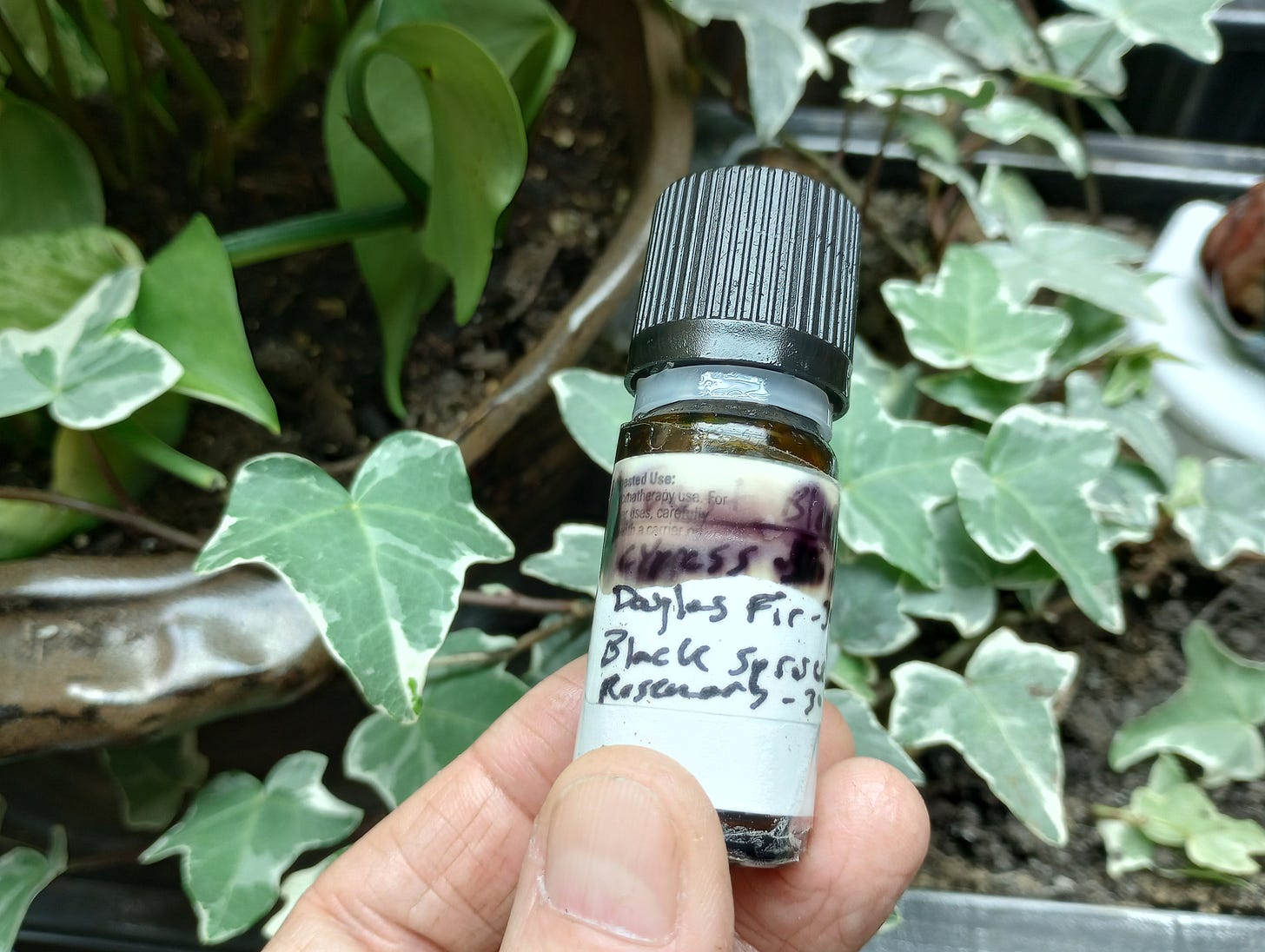
Bergamot must be why my wife and I are loving our earl gray tea right about now - helps deal with the PTSD of the holidays (:
DoTerra 'OnGuard' always did it for me when I co-slept with the babies but Lavender knocked me out last night.
I used to be addicted to Earl Grey tea too when I could still handle caffeine... Bergamot is incredible.